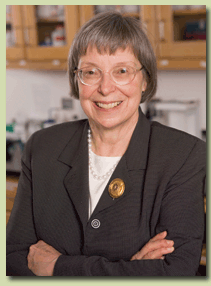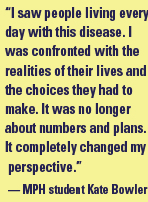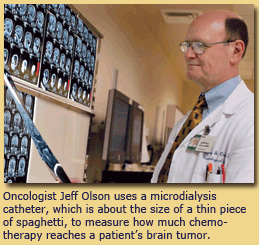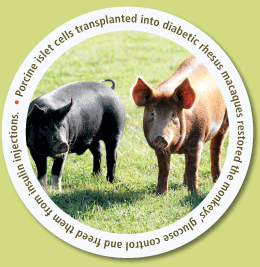|
 |
|
|












|

|
|
|
| |
 E-mail to a Friend
E-mail to a Friend
 Printer Friendly
Printer Friendly |
|
| |
|
|
|
 |
Highlights:

|
 |
 |
 |
A
higher healing power
AIDS vaccine headed for new clinical trial
Never too young
Milestones
When
AIDS gets up close and personal
New hope for bipolar moms-to-be
Nurses
get the write stuff
Neo-chemo
Hey,
you, get off of my cloud
Some strings attached
A little help from our (animal) friends
 |
 |
 |
 |
| |
|
|
 |
A
higher healing power
By
Dana Goldman
A
nurse and a theologian walking into a classroom might seem like
the setup for a good joke, but for Emory’s new Interdisciplinary
Program in Faith and Health, it’s the beginning of a beautiful
relationship.
The certificate program, run collaboratively
by the Nell Hodgson Woodruff School of Nursing and the Candler School
of Theology, is available to master’s level students in both
schools. Nursing students learn how to more fully support patients
coming from different faith traditions. Theology students explore
ways that faith communities can address the health needs of their
congregations.
“When nurses know how to work
in a faith care team, they not only bring a rich fund of health
care knowledge, but they can bring a deep understanding of spirituality
and faith as it relates to patient health,” says Darla Ura, clinical associate professor in nursing
and architect of the program, now concluding its pilot year.
health,” says Darla Ura, clinical associate professor in nursing
and architect of the program, now concluding its pilot year.
And with a rapidly aging U.S. population
and rates of chronic diseases like diabetes skyrocketing, many religious
leaders also are considering health outreach as a way to better
care for the lives—spiritual and physical—of the faithful.
But rather than the traditional church
health fairs that focus on prevention, says Ura, “we’re
actually working with the ministerial team to help the students
develop more in-depth clinic situations.”
These community collaborations may
take drastically different forms, depending on the population served
by the congregations. “If the congregation is more elderly,
we need to do more things like addressing caregiver burden,”
she says. “If it is a homeless congregation, where the members
are on their feet all day, we may consider having a podiatrist come,
or holding foot care clinics.”
The dual focus attracts students like
Daniel Calhoun, a registered nurse with more than a decade of experience
who enrolled this year in Emory’s masters in nursing program
to become an emergency nurse practitioner. As one of the 22 students
participating in the Program in Faith and Health this year (six
hail from the School of Nursing, while 14 come from the School of
Theology), he plans to use what he learns to help his patients and
to establish a parish nurse program for members of his church, Mount
Holly Church of God in Bremen.
In addition to completing coursework,
Calhoun and his classmates, who come from a range of faith traditions,
will each assess the health care needs of one congregation and design
a program to address those needs.
“This program gives students
more awareness of the relationship between faith and health,”
Calhoun explains. “I knew it would give me a good background
and a good start.”
|
 |
| |
|
|
 |
| |
|
|
|
| |
 |
AIDS
vaccine headed for new clinical trial
 The
experimental AIDS vaccine developed by researchers at the Yerkes
National Primate Research Center has progressed to a new stage in
human clinical trials. The
experimental AIDS vaccine developed by researchers at the Yerkes
National Primate Research Center has progressed to a new stage in
human clinical trials.
This April, the full experimental
vaccine will be tested in 30 human volunteers to determine whether
people can safely take it. A portion of the vaccine was tested in
people in a preliminary trial in 2003 and showed encouraging results.
The Emory-developed vaccine uses a
two-step strategy: two doses of a DNA vaccine that primes the immune
system to recognize HIV, then two doses of a recombinant pox virus
vaccine booster. Neither component contains the actual virus but
expresses three of the virus’s main proteins to stimulate
the immune system. Since it does not use any of the actual virus,
the vaccine poses no risk of infection.
This first trial is expected to last
one year and will involve giving low doses of the vaccine to healthy
volunteers. If the results are successful, then higher doses of
the vaccine will be tested. If those trials are successful, then
a third testing phase will be needed to determine the appropriate
dosing schedule to maintain immunity.
That phase, expected to last three
to four years, would need to be completed before the vaccine would
be tested in people at high-risk for getting HIV infection.
The vaccine was developed by Yerkes
researcher Harriet Robinson. In 1999, she tested a precursor to
the current vaccine in a group of rhesus macaques, finding a favorable
immune response.
Even though a workable AIDS vaccine may still be years away, this
new clinical trial will be particularly important to show whether
humans will have a similar response to that of the nonhuman primates,
Robinson says. |
 |
| |
|
|
 |
| |
|
|
|
|
 |
Never
too young
For most 13-year-olds, helping find a cure for deadly illness
is the last thing on their minds.
But not Ben Rechler. The 13-year-old
New York teenager recently sent a portion of his bar mitzvah money
to help the Emory Vaccine Center find a cure for AIDS.
During the bar mitzvah service, which
honors reaching the age of responsibility and accountability in
society, Rechler spoke about his decision: “The Emory Vaccine
Center is a research facility working hard to find a cure for AIDS. I chose this because a very close
friend of me and my family is suffering from this disease. Everyone
who knows this person loves him because he is the nicest person
you will ever meet. I think that it is time for me to help him.”
hard to find a cure for AIDS. I chose this because a very close
friend of me and my family is suffering from this disease. Everyone
who knows this person loves him because he is the nicest person
you will ever meet. I think that it is time for me to help him.”
This gift is not Rechler’s first
to the center. In 2004, both he and his sister, Willi, sent a portion
of their Chanukah money as a donation, a gift doubled by an additional
donation from their parents, Mitchell and Debbie Rechler. Ben’s
uncle, Roger Rechler, also matched Ben’s bar mitzvah donation
with one of his own.
The family friend Rechler mentioned
in his speech is Andrew Lipschitz, a physician who contracted HIV
after being exposed to an infected patient’s blood. No longer
in private practice, Lipschitz now serves as scientific adviser
for Concerned Parents for AIDS research. He recommended Emory as
a worthy place to receive Ben Rechler’s donation.
The Rechlers say they want to instill
a “culture of giving” in their household and in their
children’s lives, encouraging them to learn about different
issues and to support organizations that they value.
It’s a lesson their kids appear to have taken to heart.
|
 |
| |
|
|
 |
| |
|
|
|
|
| |
|
|
|
|
|
|
 |
Milestones
 The
National Cancer Institute (NCI) has awarded one of the
largest lung cancer research grants in the United States The
National Cancer Institute (NCI) has awarded one of the
largest lung cancer research grants in the United States
—approximately $7.5 million—to the Winship Cancer Institute
for a collaborative project to explore early diagnostic strategies
for non-small cell lung cancer and potential new therapies. Winship’s
grant is built around four scientific projects, supported by three
core laboratory facilities. The grant team is composed of 40 researchers,
clinicians, fellows and technicians from 10 departments throughout
the Woodruff Health Sciences Center. The Georgia Cancer Coalition,
Georgia’s innovative public/private cancer research partnership,
will provide additional financial support for lung cancer research
and treatment.
 The
Crawford Long Medical Office Tower, which sits on top of
Emory Crawford Long Hospital, won the Building Owner and Managers
Association’s (BOMA) 2005–2006 award for Office Building
of the Year in the medical office building category. The award recognizes
quality in office buildings and office building management. The
Crawford Long Medical Office Tower, which sits on top of
Emory Crawford Long Hospital, won the Building Owner and Managers
Association’s (BOMA) 2005–2006 award for Office Building
of the Year in the medical office building category. The award recognizes
quality in office buildings and office building management.
 Scientists
at Emory will use a $10 million grant from the National
Institutes of Health to develop new strategies for vaccination that
can better protect organ transplant recipients and other immune-suppressed
patients from infectious disease threats. The five-year grant from
the National Institute of Allergy and Infectious Diseases was awarded
to scientists in the Emory Transplant Center, the Emory Vaccine
Center, and the Yerkes National Primate Research Center. Scientists
at Emory will use a $10 million grant from the National
Institutes of Health to develop new strategies for vaccination that
can better protect organ transplant recipients and other immune-suppressed
patients from infectious disease threats. The five-year grant from
the National Institute of Allergy and Infectious Diseases was awarded
to scientists in the Emory Transplant Center, the Emory Vaccine
Center, and the Yerkes National Primate Research Center.
 Emory
has been named the top-ranked university and the No. 4
institution overall in the “Best Places to Work for Postdocs”
2006 survey conducted by The Scientist magazine. Emory ranked No.
1 among academic institutions in the list, which included the top
35 private, government, and academic institutions in North America
for post-doctoral students. The ranking was based on the approximately
470 post-doctoral students employed through Emory University School
of Medicine. Emory
has been named the top-ranked university and the No. 4
institution overall in the “Best Places to Work for Postdocs”
2006 survey conducted by The Scientist magazine. Emory ranked No.
1 among academic institutions in the list, which included the top
35 private, government, and academic institutions in North America
for post-doctoral students. The ranking was based on the approximately
470 post-doctoral students employed through Emory University School
of Medicine. |
 |
| |
|
|
 |
|
| |
| |
|
|
|
|
|
|
 |
When
AIDS gets up close and personal
 After
her first year as a student at the Rollins School of Public Health
(RSPH), Kate Bowler felt comfortable with her understanding of the
magnitude of the global AIDS epidemic. She could cite statistical
chapter and verse about the numbers of new cases reported each year,
the risk factors, and recommendations for prevention strategies.
With her peers in the Department of Global Health, she participated
in efforts to advocate for improved access to medicine and health
care for people living with HIV. After
her first year as a student at the Rollins School of Public Health
(RSPH), Kate Bowler felt comfortable with her understanding of the
magnitude of the global AIDS epidemic. She could cite statistical
chapter and verse about the numbers of new cases reported each year,
the risk factors, and recommendations for prevention strategies.
With her peers in the Department of Global Health, she participated
in efforts to advocate for improved access to medicine and health
care for people living with HIV.
That was before an O.C. Hubert Fellowship
in International Health sent her to Africa. There, she worked in
a clinic for HIV-positive mothers.
“I saw people living every day
with this disease,” Bowler says. “I was confronted with
the realities of their lives and the choices they had to make. It
was no longer about numbers and plans. It completely changed my
perspective.”
Bowler’s experience helped her
better understand the complexities of working in public health in
an international context, she says. Being “on the ground”
gave her a first-person understanding of local resources and how
health messages are perceived and used in a given community.
“Because of this experience,
I truly feel better prepared to go out and make a difference,”
she says.
Bowler and another student, Erin Jones,
shared stories of their field research at the March 30 dedication
of the school’s newly named Hubert Department of Global Health.
The name honors the Hubert Foundation, a family charity with a longstanding
commitment to global health at Emory.
In addition to funding global field
research fellowships each year, the foundation has endowed the Ruth
and O.C. Hubert Chair in Religion and Health and the William H.
Foege Chair in Global Health. Foege, presidential distinguished
professor of global health, was instrumental in introducing the
Huberts to the work at the RSPH. Keith Klugman, the world’s
leading expert on antibiotic resistance in pneumonia, is the first
Foege chair.
Now, with additional support bringing
its commitment to $10 million, the Hubert family is allowing the
school to expand its already impressive global health reach. The
gift establishes the Richard N. Hubert Fund for Global Health Excellence, which will help develop
more international programs and recruit additional faculty and staff.
Hubert Fund for Global Health Excellence, which will help develop
more international programs and recruit additional faculty and staff.
The Hubert Foundation needs Emory
and the RSPH as much as they need it, says Richard Hubert, a trustee
of the family’s foundation, which honors his father, a self-made
businessman who at his death in 1986 was the largest private individual
owner of property in Cobb County, Georgia, and his mother, 95, who
attended the dedication.
“You are the ones who are helping
us fulfill the lofty goals of this foundation’s mission, which
is to alleviate suffering around the world,” he says. “We
have the money, but we don’t have the people to go out and
do the work. You are the ones with the knowledge and the willingness
to go solve problems. If we can provide the means that will allow
you to do this, then we will do it.”
Photographs by Erin
Jones. |
 |
| |
|
|
 |
|
| |
| |
| |
| |
|
|
 |
New
hope for bipolar moms-to-be
Women
with bipolar disorder who want to have children are often faced
with a wrenching decision: Should they risk stopping their medication
when they become pregnant? Or do they keep taking it and risk the
exposure of the developing child?
A new study by Emory researchers indicates
that expectant mothers may safely continue to use one of the most
common medications within certain guidelines.
“Women with untreated bipolar
disorder do not do well during pregnancy and are particularly vulnerable
during the postpartum period,” says Jeffrey Newport, associate
director of the Emory Women’s Mental Health Program and leader
of a research team examining this issue. In fact, bipolar pregnant women who discontinue
treatment have a greater than 80% likelihood of relapse during pregnancy.
And a woman with bipolar disorder is 100 times more likely than
the average woman to suffer postpartum psychosis.
examining this issue. In fact, bipolar pregnant women who discontinue
treatment have a greater than 80% likelihood of relapse during pregnancy.
And a woman with bipolar disorder is 100 times more likely than
the average woman to suffer postpartum psychosis.
Newport’s team studied whether
halting lithium just prior to delivery would reduce the level of
the drug in a newborn’s blood and lower the rate of complications.
They found that neonatal adverse events were related to higher lithium
concentrations in the blood of newborns, but that withholding lithium
for 24 to 48 hours prior to delivery significantly reduced the concentration.
Lithium use during pregnancy is controversial
because the drug does cross the placenta. Babies born to mothers
who take lithium have levels of the drug in the bloodstream after
birth, and lithium can cause side effects such as lower Apgar scores,
longer hospital stays, and higher rates of cardiac, neuromuscular,
and central nervous system defects. But few researchers have ever
examined ways to limit fetal exposure to lithium short of asking
pregnant women taking the drug to stop.
Given the recent study’s results,
which were published in the November 2005 issue of the American
Journal of Psychiatry, Newport has proposed guidelines for continuing
lithium use during pregnancy for women who are at high-risk of experiencing
complications without it. |
 |
| |
|
|
 |
| |
|
|
|
|
|
| |
|
|
|
| |
 |
Nurses
get the write stuff
By
Pam Auchmutey
Filling prescriptions became easier for patients and health
care providers with a new state law. Signed by Gov. Sonny
Perdue and effective July 1, the law expands the authority of advanced
practice registered nurses (APRNs) to prescribe medications under
certain conditions.
Nurses’ “right to write”
has been more than a decade in coming. That’s how long APRNs
and their supporters have lobbied state legislators to change the
law, a move previously opposed by the Medical Association of Georgia. Until now, Georgia was the only
state that did not grant APRNs—nurse practitioners, nurse-midwives,
nurse anesthetists, and psychiatric/mental health nurses—prescriptive
authority. Now they can write prescriptions to treat common illnesses—cold,
flu, and ear infections—and chronic illnesses such as diabetes
or asthma, all within strict guidelines in consultation with a supervising
physician.
Medical Association of Georgia. Until now, Georgia was the only
state that did not grant APRNs—nurse practitioners, nurse-midwives,
nurse anesthetists, and psychiatric/mental health nurses—prescriptive
authority. Now they can write prescriptions to treat common illnesses—cold,
flu, and ear infections—and chronic illnesses such as diabetes
or asthma, all within strict guidelines in consultation with a supervising
physician.
Many at the Woodruff Health Sciences
Center were among those working behind the scenes to move the legislation
forward. Marla Salmon, dean of the Nell Hodgson Woodruff School
of Nursing, and Lucy Marion, dean of nursing at the Medical College
of Georgia, met with key legislators to urge passage of the law,
as did Linda Womack, director of state affairs for the University.
Maureen Kelley, chair of the Department of Family and Community
Nursing, testified before a House subcommittee in support of the
bill. Wright Caughman, director of The Emory Clinic, also visited
the legislature to express support for the bill on behalf of the
clinic and Emory physician leaders. Last but not least, Health Sciences
Center CEO Michael Johns, School of Medicine Dean Thomas Lawley,
and Salmon sent a joint letter of support to every member of the
Georgia House and Senate.
“The power of this nurse-physician
partnership proved that prescriptive authority is a winning proposition
for better access and quality of care for Georgians, especially
those in rural or underserved areas,” says Salmon.
Proponents of the new law believe
it will save time and frustration for patients, nurses, and physicians
by streamlining the prescription process. And it will be a definite
plus for patients in areas with few doctors and where nurses often
serve as the touchstone to primary care. |
 |
| |
|
|
 |
|
|
|
| |
|
|
|
| |
| |
|
|
 |
Neo-chemo
Emory’s
Winship Cancer Institute is pioneering new treatments through more
than 115 clinical trials.
For example, Winship is the only cancer
facility in Georgia offering a phase 2 trial for transitional cell
carcinoma, a common form of bladder cancer. Researchers are testing
the effectiveness of the experimental drug Vinflunine. Previous
studies have shown that the drug exhibits anti-tumor activity by
inhibiting cell division. The purpose of this trial is to see whether
the drug will shrink tumors or slow their growth in patients with
advanced bladder cancer that is worsening despite chemotherapy.
Winship is one of only two cancer
research facilities in the country to conduct a procedure to determine
how much chemotherapy actually reaches certain kinds of brain tumors.
In the procedure, a tiny tube called a microdialysis catheter is
inserted directly into the patient’s brain tumor. The patient then
receives an intravenous infusion of methotrexate, a chemotherapy
drug. Researchers use the catheter to remove fluid directly from
the tumor. They hope to determine exactly how much of the drug reaches
the tumor by removing fluid for 24 hours after the chemotherapy
is delivered.
directly into the patient’s brain tumor. The patient then
receives an intravenous infusion of methotrexate, a chemotherapy
drug. Researchers use the catheter to remove fluid directly from
the tumor. They hope to determine exactly how much of the drug reaches
the tumor by removing fluid for 24 hours after the chemotherapy
is delivered.
Patients in the study have recurrent,
malignant, high-grade gliomas, one of the most difficult types of
brain tumors to treat.The American Cancer Society estimates that
malignant tumors of the brain or spinal cord account for 2.2% of
all deaths.
Winship researchers also are participating
in a phase 3 multi-center, international study that found that bortezomib,
one of a new class of drugs known as proteosome inhibitors, showed
promise against multiple myeloma, as reported in the New England
Journal of Medicine last June.
Multiple myeloma, a plasma cell
malignancy, is diagnosed in approximately 15,000 people in the United
States annually and accounts for some 11,000 deaths each year. Although
high-dose chemotherapy and bone marrow transplant have shown some
success in treatment, median survival remains three to five years
and virtually all patients evenutally die of the disease.
Winship’s study sets the stage
for the next major revolution in myeloma therapy with bortezomib.
Unlike traditional chemotherapy drugs, this drug works at the molecular
level to interrupt the mechanism that myeloma cells use to reproduce
themselves. “If you reduce the number of cancer cells, you
reduce the malignancy,” says Winship hematologist Sagar Lonial,
one of the authors of the report.
What makes this drug exciting to investigators
is that it targets only the malignant cells and has less impact
on normal cells.
Finally, Winship was the first cancer
facility in the country to open a trial of a new combination of
chemopreventive drugs for the oral cavity and larynx in former smokers.
Researchers are studying premalignant lesions of the oral cavity
and larynx in former smokers, using a combination of erlotinib and
celecoxib to block epidermal growth factor receptor (EGFR) mediated
signaling and to inhibit cyclooxygenase-2 mediated pathways.
Erlotinib blocks EGFR tyrosine kinase
protein messaging, which tells cancer cells to grow and divide,
and celecoxib is an anti-inflammatory that reduces cell formation,
blood vessel formation, and metastases. Individually, the drugs
have been found to be effective chemopreventive agents. This study
will evaluate the safety and effectiveness of the two drugs in combination.
|
 |
| |
|
|
 |
| |
|
|
|
|
|
| |
|
|
|
| |
| |
|
|
 |
Hey,
you, get of of my cloud
 Contrary
to the Rolling Stones’ classic, sometimes you can get some
satisfaction. Psychiatrist Gregory Berns has developed a theory
about how people do so in Satisfaction: The Science of Finding
True Fulfillment. He
bases the theory on MRI studies done in his Emory lab on how the
brain functions during tasks that have a level of uncertainty, novelty,
and decision-making. His conclusion: satisfaction seems to come
from doing something novel, whether it’s running a marathon
or finishing a crossword puzzle. Tasks such as these tap directly
into motivation centers in the brain. Contrary
to the Rolling Stones’ classic, sometimes you can get some
satisfaction. Psychiatrist Gregory Berns has developed a theory
about how people do so in Satisfaction: The Science of Finding
True Fulfillment. He
bases the theory on MRI studies done in his Emory lab on how the
brain functions during tasks that have a level of uncertainty, novelty,
and decision-making. His conclusion: satisfaction seems to come
from doing something novel, whether it’s running a marathon
or finishing a crossword puzzle. Tasks such as these tap directly
into motivation centers in the brain.
“Everything I have encountered
inside the research lab and out in the world suggests that satisfaction
is not the same as either pleasure or happiness,” Berns says.
“Searching for happiness will not necessarily lead to satisfaction.”
|
 |
| |
|
|
 |
| |
|
|
|
|
|
| |
|
|
|
| |
| |
|
|
 |
Some
strings attached
 When
cardiologist Joel Felner was a boy, his father presented him with
a special violin. The violin was made by Giovanni Grancino
in 1687 in Milan, Italy. But the gift came with strings attached,
literally. When
cardiologist Joel Felner was a boy, his father presented him with
a special violin. The violin was made by Giovanni Grancino
in 1687 in Milan, Italy. But the gift came with strings attached,
literally.
Felner was required to practice for
an hour every day while his father listened. His dad, a physician,
had an office in the family home, and on more than one occasion
Felner remembers his father interrupting a patient visit to come
to where Felner was practicing and correct a wrong note.
Music and doctoring run in the Felner
family. Felner’s father had studied at Edinburgh College,
where he could pursue an education in medicine and at the same time
play in the symphony to earn some money. The violin next passed
to Felner’s cousin, Peter Bornstein, who played in the London
Philharmonic. Felner got his turn on the violin at age 12, when
the instrument was appraised at $32,000. He completed his medical
studies at Columbia and violin studies with the combined Columbia-Julliard
orchestra. Both his sons have earned MDs from Emory, but that’s
where the violin lessons stop. Neither Kevin nor Eric Felner took
to the instrument.
After a neck injury and a weakened
left hand interfered with Felner’s own playing some 15 years
ago, the instrument has been silent. Recently, Felner gave the Grancino
to the Emory Symphony Orchestra. “Donating it was a way of
having it around but getting some use out of it,” he says.
The Grancino is valued at $270,000
in today’s currency. In recognition of the gift, the symphony
has created the Joel M. Felner MD Chair, which will be occupied
each year by the concertmaster. This auditioned chair who heads
the violin section will play the Grancino during concerts, and this
fall will mark the debut concert for the Grancino. This violin was
one of two instruments donated to the University Symphony this year,
the second made by Giuseppe Scarampella of Florence with a value
of approximately $45,000.
“The best feeling I ever had
was when I gave this violin to Emory,” says Felner, who has
served on Emory’s medical faculty for 35 years. |
 |
| |
|
|
 |
| |
|
|
|
|
|
| |
|
|
|
| |
 |
A
little help from our (animal) friends
Surgeons have successfully reversed type 1 diabetes in humans
by transplanting islet cells, but their success is limited by the
availability of these islet cells. More than 1 million
Americans have the disease, but each year, only 3,000 to 4,000 donor
pancreases are available. And each can produce enough cells for,
at most, only one transplant.
Enter a promising near-term solution:
islet cell xenotransplantation. Researchers from the Emory Transplant
Center and Yerkes National Primate Research Center have transplanted
insulin-producing neonatal porcine islet cells harvested by University
of Alberta (Canada) researchers into diabetic rhesus macaque monkeys. The transplant restored the monkeys’ glucose control
and allowed them to be free from sustained insulin injections.
monkeys. The transplant restored the monkeys’ glucose control
and allowed them to be free from sustained insulin injections.
This research, published in the February
26 advanced online edition of Nature Medicine, also examines
the effectiveness of a costimulation blockade-based regimen developed
at Emory that has been proven to have fewer toxic side effects than
currently used immunosuppressive regimens.
Belatacept is a key ingredient in
the costimulation blockade regimen that selectively blocks the second
of two cellular signals the body needs to trigger an immune response.
This regimen is less complex than the immunosuppressant compounds
used in previous research, and its simplicity will make it more
applicable in clinical use, says Larsen.
In addition, the researchers addressed
concerns of the possibility of cross-species disease transmission
as a result of xenotransplantation. After extensive testing, they
found no evidence of transmission of porcine endogenous retroviruses
from the porcine cells to the transplant animals. The use of nonhuman
primates was critical for testing cross-species viral transmission
because of their close genetic link to humans, according to Larsen.
The next step is to prove porcine
islet cells can be a source for human transplantation and to verify
the safety of the transplant procedures, a process researchers hope
to begin in the next three to five years. |
 |
| |
|
|
 |
|
|
|
| |
|
|
|
| |
|
|
|
| |
|
|
|





 health,” says Darla Ura, clinical associate professor in nursing
and architect of the program, now concluding its pilot year.
health,” says Darla Ura, clinical associate professor in nursing
and architect of the program, now concluding its pilot year. 

 The
experimental AIDS vaccine developed by researchers at the Yerkes
National Primate Research Center has progressed to a new stage in
human clinical trials.
The
experimental AIDS vaccine developed by researchers at the Yerkes
National Primate Research Center has progressed to a new stage in
human clinical trials.

 hard to find a cure for AIDS. I chose this because a very close
friend of me and my family is suffering from this disease. Everyone
who knows this person loves him because he is the nicest person
you will ever meet. I think that it is time for me to help him.”
hard to find a cure for AIDS. I chose this because a very close
friend of me and my family is suffering from this disease. Everyone
who knows this person loves him because he is the nicest person
you will ever meet. I think that it is time for me to help him.”


 After
her first year as a student at the Rollins School of Public Health
(RSPH), Kate Bowler felt comfortable with her understanding of the
magnitude of the global AIDS epidemic. She could cite statistical
chapter and verse about the numbers of new cases reported each year,
the risk factors, and recommendations for prevention strategies.
With her peers in the Department of Global Health, she participated
in efforts to advocate for improved access to medicine and health
care for people living with HIV.
After
her first year as a student at the Rollins School of Public Health
(RSPH), Kate Bowler felt comfortable with her understanding of the
magnitude of the global AIDS epidemic. She could cite statistical
chapter and verse about the numbers of new cases reported each year,
the risk factors, and recommendations for prevention strategies.
With her peers in the Department of Global Health, she participated
in efforts to advocate for improved access to medicine and health
care for people living with HIV. Hubert Fund for Global Health Excellence, which will help develop
more international programs and recruit additional faculty and staff.
Hubert Fund for Global Health Excellence, which will help develop
more international programs and recruit additional faculty and staff. examining this issue. In fact, bipolar pregnant women who discontinue
treatment have a greater than 80% likelihood of relapse during pregnancy.
And a woman with bipolar disorder is 100 times more likely than
the average woman to suffer postpartum psychosis.
examining this issue. In fact, bipolar pregnant women who discontinue
treatment have a greater than 80% likelihood of relapse during pregnancy.
And a woman with bipolar disorder is 100 times more likely than
the average woman to suffer postpartum psychosis. Medical Association of Georgia. Until now, Georgia was the only
state that did not grant APRNs—nurse practitioners, nurse-midwives,
nurse anesthetists, and psychiatric/mental health nurses—prescriptive
authority. Now they can write prescriptions to treat common illnesses—cold,
flu, and ear infections—and chronic illnesses such as diabetes
or asthma, all within strict guidelines in consultation with a supervising
physician.
Medical Association of Georgia. Until now, Georgia was the only
state that did not grant APRNs—nurse practitioners, nurse-midwives,
nurse anesthetists, and psychiatric/mental health nurses—prescriptive
authority. Now they can write prescriptions to treat common illnesses—cold,
flu, and ear infections—and chronic illnesses such as diabetes
or asthma, all within strict guidelines in consultation with a supervising
physician. directly into the patient’s brain tumor. The patient then
receives an intravenous infusion of methotrexate, a chemotherapy
drug. Researchers use the catheter to remove fluid directly from
the tumor. They hope to determine exactly how much of the drug reaches
the tumor by removing fluid for 24 hours after the chemotherapy
is delivered.
directly into the patient’s brain tumor. The patient then
receives an intravenous infusion of methotrexate, a chemotherapy
drug. Researchers use the catheter to remove fluid directly from
the tumor. They hope to determine exactly how much of the drug reaches
the tumor by removing fluid for 24 hours after the chemotherapy
is delivered.  Contrary
to the Rolling Stones’ classic, sometimes you can get some
satisfaction. Psychiatrist Gregory Berns has developed a theory
about how people do so in Satisfaction: The Science of Finding
True Fulfillment. He
bases the theory on MRI studies done in his Emory lab on how the
brain functions during tasks that have a level of uncertainty, novelty,
and decision-making. His conclusion: satisfaction seems to come
from doing something novel, whether it’s running a marathon
or finishing a crossword puzzle. Tasks such as these tap directly
into motivation centers in the brain.
Contrary
to the Rolling Stones’ classic, sometimes you can get some
satisfaction. Psychiatrist Gregory Berns has developed a theory
about how people do so in Satisfaction: The Science of Finding
True Fulfillment. He
bases the theory on MRI studies done in his Emory lab on how the
brain functions during tasks that have a level of uncertainty, novelty,
and decision-making. His conclusion: satisfaction seems to come
from doing something novel, whether it’s running a marathon
or finishing a crossword puzzle. Tasks such as these tap directly
into motivation centers in the brain. When
cardiologist Joel Felner was a boy, his father presented him with
a special violin. The violin was made by Giovanni Grancino
in 1687 in Milan, Italy. But the gift came with strings attached,
literally.
When
cardiologist Joel Felner was a boy, his father presented him with
a special violin. The violin was made by Giovanni Grancino
in 1687 in Milan, Italy. But the gift came with strings attached,
literally.  monkeys. The transplant restored the monkeys’ glucose control
and allowed them to be free from sustained insulin injections.
monkeys. The transplant restored the monkeys’ glucose control
and allowed them to be free from sustained insulin injections.